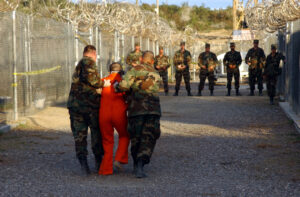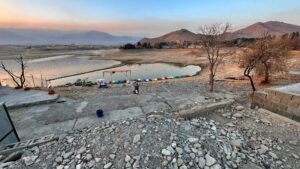How the Women of Pakistan Cope With War, Honor Killings and Prejudice
The West is flooded by news of all the incessant outrages, but by looking back at history we get a better understanding of what is happening in this forsaken country of ours. Progress is never linear. A woman prays at the shrine of Shah Chun Chirag in Rawalpindi, Pakistan. AP/B.K. Bangash
A woman prays at the shrine of Shah Chun Chirag in Rawalpindi, Pakistan. AP Photo/B.K. Bangash
A woman prays at the shrine of Shah Chun Chirag in Rawalpindi, Pakistan. AP/B.K. Bangash
A woman prays at the shrine of Shah Chun Chirag in Rawalpindi, Pakistan. AP Photo/B.K. Bangash
Editor’s note: This is the first article in a new Truthdig initiative called Global Voices: Truthdig Women Reporting. The project creates a network of female foreign correspondents in collaboration with the International Women’s Media Foundation. These writers come from various countries and have all been honored by the IWMF for their courageous journalism. Since 1990, the IWMF’s awards have recognized female reporters who risk their lives to expose the truth around the world.
Click here to support the women of Global Voices with a tax-deductible donation.
How do women cope in Pakistan? This is a question I am very frequently asked by people in the West who are flooded by news of all the incessant outrageous happenings in my country. One cannot deny that in times of crisis that have global bearings — as in the Afghan war of the 1980s and the post-9/11 years — Pakistan receives more than its share of publicity in the international media. Regrettably, most of it is negative. And quite a lot of it is also true.
However, like the proverbial half-empty or half-full glass, the impression one forms depends on the context in which one sees a situation. Since the reporting tends to be heavily based on received wisdom, the truth does not emerge fully. As a result, only the bad news of the half-empty glass is reported, which reinforces the fears of skeptics: The fires of violence in Pakistan will engulf the world and destroy it. But there is no mention of the half-full glass that gives many of us hope.
True, Pakistanis — especially women — have been victims of centuries-old gender prejudices and biases. The status of women had begun to improve, as statistics show and as many women like me know from our personal experience, when war and the resultant radicalization came as a major setback. The militants such as al-Qaida, the Taliban and their countless affiliates as well as their predecessors, the mujahedeen, who were actually used as proxies by the Americans to turn Afghanistan into a “Soviet Vietnam,” resorted to retrogressive strategies in the name of religion and jihad. Thus the dark ages for the women of Pakistan were revived.
By looking back at history we get a better understanding of what is happening in this forsaken country of ours. What we witness today is a clash between the forces of obscurantism and bigotry that have re-emerged with Islamic militancy on the one hand and the elements of enlightenment that have stood for the empowerment and emancipation of women on the other.
The situation is more complex than is believed. Two factors have made it so. First is the dichotomy in Pakistani society, as in most other Third World countries, that is so striking. Progress — especially social advancement — is never linear. Two steps forward, one step back, that is the norm. Some sections of the population move ahead. Others are slower.
The second basic truth is that the country is divided between two unequal sections, the haves and the have-nots. They represent not just the economically privileged and the poverty stricken. They also reflect social realities. It is not a coincidence that the wealthy have better education, health care and opportunities in life compared with the poor who are downtrodden.
Recently the case of a woman who exercised her right to marry a man of her own choosing and was bludgeoned to death by her own family created much sensation. The slaying was dubbed an honor killing, though most sane people believe such foul deeds bring only dishonor. It revived painful memories of previous highly publicized and abhorrent cases of homicide. There are many similar evils that have been endemic, making the lives of women oppressive and leaving them depressed, with many unable to fight back.
These make headlines as do the high rates of maternal and infant mortality that kill thousands of women every year. Then there is the fact of millions of girls being denied the opportunity of going to school to receive education and skills that would help them improve their lives. The 2012 attack against schoolgirl Malala Yousafzai made shocking reading.
But this is only one side of the coin. There is another side. Malala fought back and was not cowed down as numerous others have followed the same course. Ours is also a country that boasts of having had the first female prime minister in the Muslim world, where young women are flying aircraft for the air force, qualified female doctors and surgeons provide health care in hospitals and eminent female scholars have emerged in academia, while female lawyers and administrators have proved their mettle.
They can cope because most of them come from that privileged section of the population that has the advantages that enlightenment, education and economic empowerment offer in fighting off gender prejudices.
It is this brighter side of the coin that gives rise to hope in an otherwise hopeless situation. The two worlds, alienated from each other for ages in Pakistan, are now trying to come together. While one — the bigoted and conservative — does not want change to come and is trying to drag the country into the chasm of darkness, the other, enlightened one is fighting back. This struggle manifests itself in the women’s situation.
We have brave women trying to improve the lives of their compatriots by reducing the deprivation of the underprivileged majority and giving it the strength and capacity to fight back. Three examples will suffice to demonstrate the trend.
The Indus Resource Centre, established in 2000, is working to develop “replicable models for integrated social and economic development in Pakistan,” as stated on its website. It has grown from being a one-woman setup — founded by Executive Director Sadiqa Salahuddin — to an effective organization with 834 people with several projects in various parts of Sindh province. Its initial focus was capacity building but it has moved on to wider goals such as education for girls, poverty elimination and advocacy support.
The IRC is sharply focused on women. The preponderance of women on its staff is evidence of its pro-women policy. Of its total staff, 563 are women. It also has 83 part-time female artisans working for it. In the 130 IRC-run schools, girls outnumber boys 4,804 to 3,520.
Salahuddin describes the IRC’s gender policy as being intentionally and proactively designed to promote gender equity. She gives an example: “The school admission policy says that IRC schools are basically for girls but male siblings can be admitted. So every boy who is in the school is with reference to a girl.”
The Ali Hasan Mangi Memorial Trust in Khairo Dero, a hamlet in Sindh, is run by Naween Mangi. She is trying to bring about a silent revolution in Sindh and women form the key element in her strategy as she insists on gender equity. The trust employs 12 office workers and teachers, six of whom are female. Among the volunteers, five are boys and three are girls. The trust has facilitated education-focused nongovernmental organization TCF’s setting up of a school in Khairo Dero that enrolls 102 girls and 99 boys. In the trust’s own community school, which picks up street children for informal education, 24 girls and 26 boys attend class daily.
|
Click here to support the women of Global Voices with a tax-deductible donation. |
Mangi explained that the social environment in Pakistan, especially in rural areas, is conservative, and she has had to work hard “to encourage women and their families to allow women to attend training sessions and work outside the home.”
She added, “I personally work with our women community workers to guide them on how to work effectively in a mixed gender environment, which they initially found very daunting. Aside from employment, we have a strong gender policy: Our loan program is only for women, we only provide housing assistance when women apply, all the gas connections we provide are in the name of the woman of the house and our community meetings are for women based around topics that interest them.”
The Garage School, which Shabina Mustafa started in Karachi in 1999 to impart education to girls, is benefiting women even without a strong gender policy. The staff consists of seven men and 24 women, and two male and five female volunteers. In terms of students, there are 264 girls and 172 boys. The beneficiaries of its newly launched teachers training center are 60 women with a solitary male trainee.
Being located in Karachi, Pakistan’s biggest city, TGS finds women to be relatively liberated. Mustafa provides health and nutrition facilities to the community in the neighborhood, and women benefit most.
There are many similar projects scattered all over Pakistan. Many are pointedly working for the uplift of women. The winds of change are now blowing. What the world hears today in the shape of horrendous stories of women being stoned to death, little girls being shot in the head for going to school and victimized women fighting back (like Mukhtaran Mai, who was gang raped on the orders of a tribal assembly but retaliated by setting up a school in her village) are basically manifestations of women’s courage to challenge the misogynist reaction of those who fear change. We will have to wait and see who wins.
Your support matters…Independent journalism is under threat and overshadowed by heavily funded mainstream media.
You can help level the playing field. Become a member.
Your tax-deductible contribution keeps us digging beneath the headlines to give you thought-provoking, investigative reporting and analysis that unearths what's really happening- without compromise.
Give today to support our courageous, independent journalists.






You need to be a supporter to comment.
There are currently no responses to this article.
Be the first to respond.